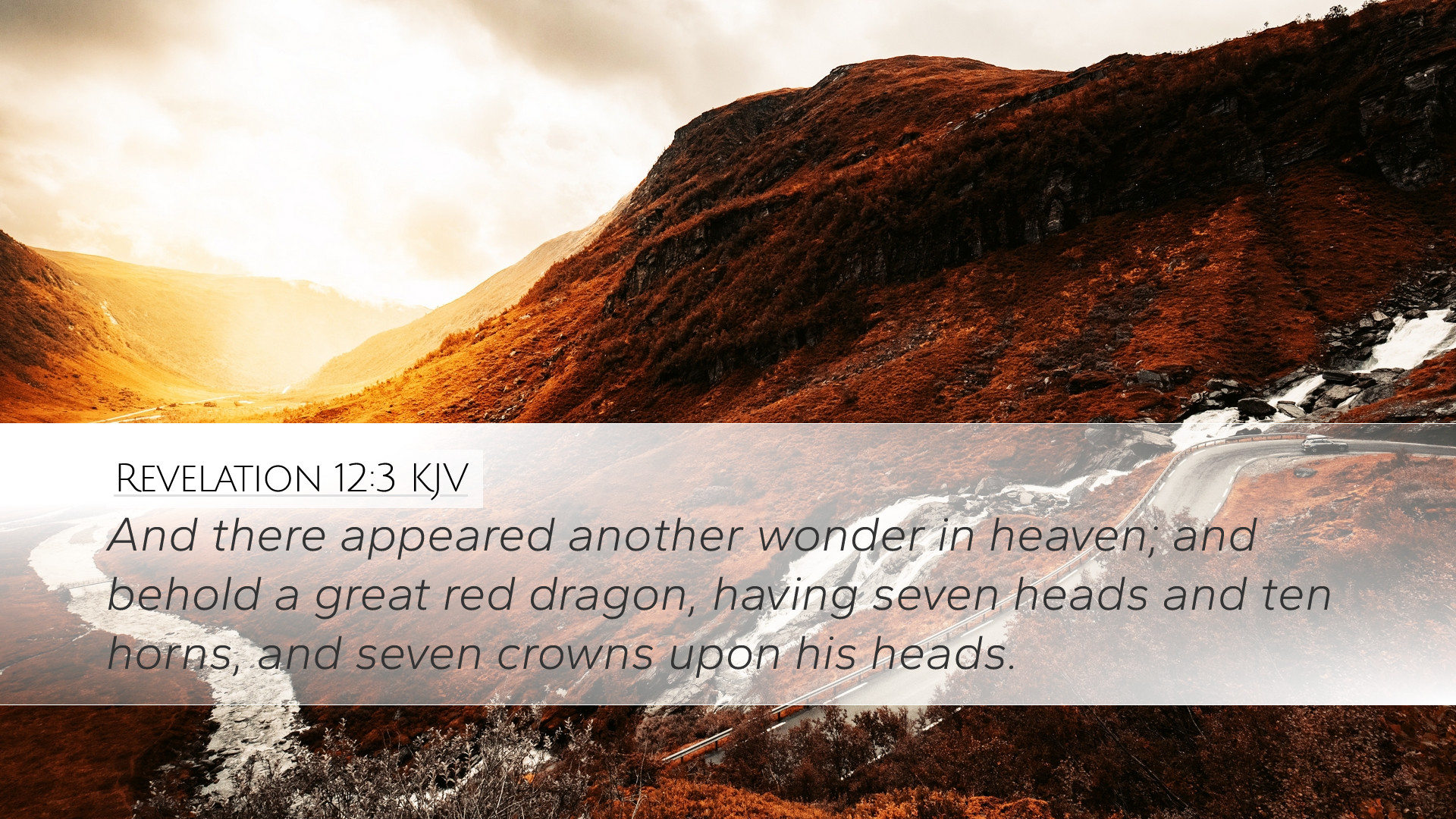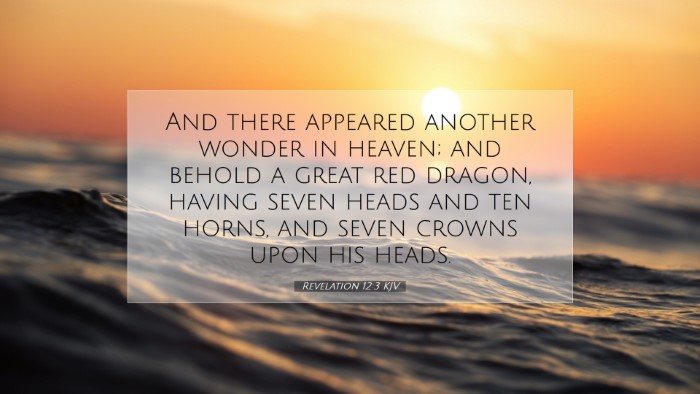Commentary on Revelation 12:3
Revelation 12:3 (KJV) states:
"And there appeared another wonder in heaven; and behold a great red dragon, having seven heads and ten horns, and seven crowns upon his heads."
Introduction
This verse introduces one of the central symbols in John's apocalyptic vision, the great red dragon. The imagery serves to represent not just a single entity but embodies themes of power, rebellion, and opposition to God. Various public domain commentaries elucidate the significance and implications of this vivid portrayal, offering valuable insights to pastors, students, and scholars alike.
Symbolism of the Dragon
Matthew Henry emphasizes that the dragon is a representation of Satan. He notes that the color red signifies bloodshed and destruction, embodying the violence and hostility that characterizes the forces of evil. Furthermore, Henry expands on the idea of the dragon having multiple heads and horns as indicative of the complex and multifaceted nature of evil powers throughout history.
Albert Barnes also contributes to the understanding of this symbol by interpreting the seven heads as representative of the completeness of wisdom and authority. The dragon's many horns suggest its strength and ability to exert influence within earthly kingdoms. Thus, the image of the dragon encapsulates the struggle believers face against the formidable and organized forces of evil.
Cultural and Historical Context
Adam Clarke offers insights into the cultural perceptions of dragons in biblical times, noting that they were often seen as extraordinarily powerful creatures, associated with chaos and destruction. In the context of the Roman Empire, the dragon may symbolize imperial power and the persecution of the early Church. The number seven has significant biblical meaning, often representing perfection or completion, which Clarke correlates with the dragon's complete dominion over worldly systems opposed to God.
Interpretive Challenges
Each commentary presents interpretive challenges within Revelation 12:3, as the imagery can be multifaceted. Henry notes that the presence of a dragon can invoke fear and thus serves as a reminder to believers to stand firm in their faith despite opposition.
Barnes cautions readers to avoid overly literal interpretations, suggesting that understanding the symbolic nature of apocalyptic literature is crucial. He argues that the dragon forces believers to contemplate the broader spiritual warfare at play, encouraging a perspective that sees beyond the surface to grasp the timeless relevance of these images.
Theological Implications
The theological implications of this imagery are profound. As Clarke points out, the portrayal of the great red dragon embodies the ongoing conflict between good and evil. This prevalent theme throughout Scripture is essential for understanding the nature of spiritual warfare that believers are called to engage in.
Furthermore, the dragon's defeat, referenced later in Revelation, serves as a beacon of hope for those grappling with the existential threats posed by evil in the world. Henry concludes that the vision ultimately underscores the victory of Christ over Satan, affirming the promise that faith will overcome evil.
Pastoral Application
This powerful imagery provides a rich foundation for pastoral sermons and teachings. Pastors may draw from the commentary insights to encourage their congregations not to be intimidated by the forces of evil represented by the dragon. Instead, believers are reminded of their identity in Christ and the assurance that they are part of a victorious community.
- Encouragement in Struggle: Highlighting that believers are not alone in their struggles against evil forces.
- Hope in Christ's Victory: Emphasizing that Christ has already secured victory over sin and evil.
- Awareness of Spiritual Warfare: Teaching congregants to be aware of the spiritual realities that affect their daily lives.
Conclusion
Revelation 12:3 serves as a powerful reminder of the spiritual realities and cosmic battles believers face. The insights gleaned from public domain commentaries enrich our understanding of this verse and encourage a heightened awareness of the presence of evil, while simultaneously affirming the ultimate triumph of God’s purposes. As we reflect on the great red dragon, we are called not only to understand the symbolic implications but to engage actively in the Christian journey with courage and conviction.


